wheel MITSUBISHI iMiEV 2015 Owner's Manual (in English)
[x] Cancel search | Manufacturer: MITSUBISHI, Model Year: 2015, Model line: iMiEV, Model: MITSUBISHI iMiEV 2015Pages: 262, PDF Size: 26.84 MB
Page 8 of 262

Outside (Rear)
Overview 1-6
1
N00100602463
Outside (Rear)
Back-up light P.9-22, 9-25
Antenna P.7-22
Tail and stop lights P.5-44, 9-22, 9-25
High-mounted stop light P.9-22, 9-27
Rear turn signal lights P.5-46, 9-22, 9-25
Rear window wiper P.5-49
Keyless entry system P. 5 - 5Locking and unlocking P. 5 - 8
Liftgate P.5-11
License plate lights P.5-44, 9-22, 9-28
Regular charge port light P.3-16, 9-22
Regular charging lid P.3-16 Tire pressure monitoring system P.5-30 Size of tires and wheels P.11-5 Tire inflation pressure P.9-13 Tire rotation P.9-15Tire chains P.9-16
Rear side-marker lights P.5-44, 9-22, 9-26
BK0209800US.book 6 ページ 2014年1月14日 火曜日 午前9時26分
Page 13 of 262
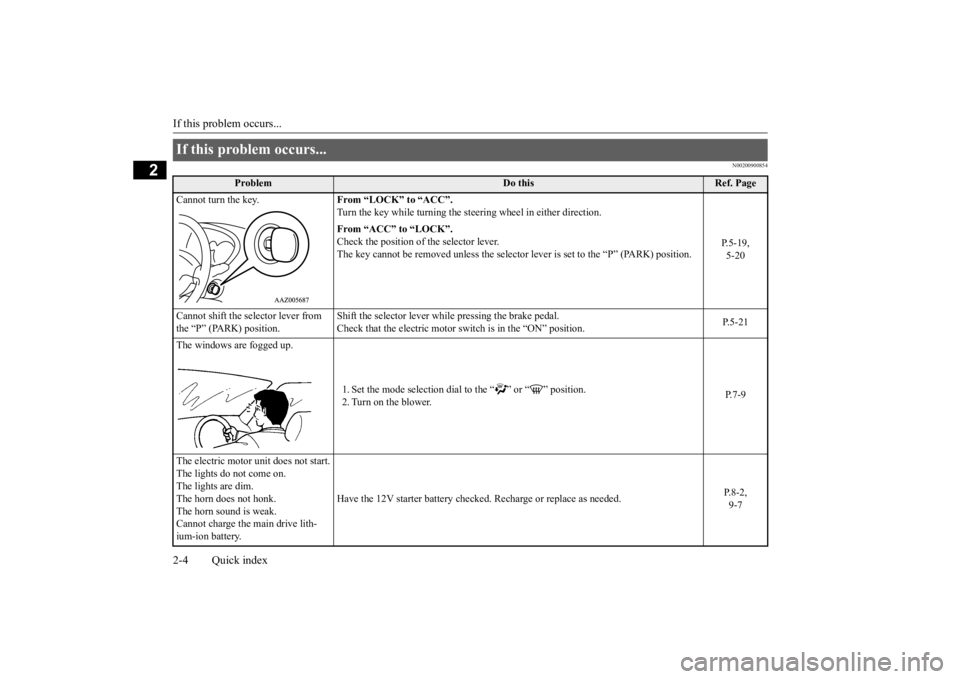
If this problem occurs... 2-4 Quick index
2
N00200900854
If this problem occurs...
Problem
Do this
Ref. Page
Cannot turn the key.
From “LOCK” to “ACC”. Turn the key while turning the st
eering wheel in either direction.
P.5-19, 5-20
From “ACC” to “LOCK”. Check the position of the selector lever. The key cannot be removed unless the selector
lever is set to the “P” (PARK) position.
Cannot shift the selector lever from the “P” (PARK) position.
Shift the selector lever wh
ile pressing the brake pedal.
Check that the electric motor switch is in the “ON” position.
P.5-21
The windows are fogged up.
1. Set the mode selection dial
to the “ ” or “ ” position.
2. Turn on the blower.
P.7-9
The electric motor unit does not start. The lights do not come on. The lights are dim. The horn does not honk. The horn sound is weak. Cannot charge the main drive lith-ium-ion battery.
Have the 12V starter battery checked.
Recharge or replace as needed.
P.8-2, 9-7
BK0209800US.book 4 ページ 2014年1月14日 火曜日 午前9時26分
Page 14 of 262
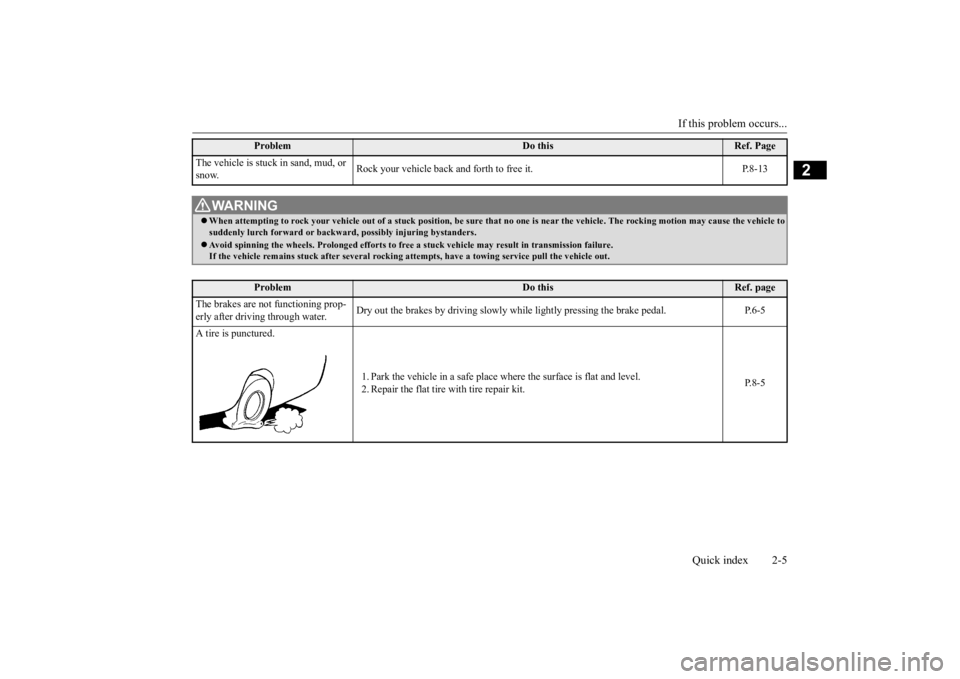
If this problem occurs...
Quick index 2-5
2
The vehicle is stuck
in sand, mud, or
snow.
Rock your vehicle back and forth to free it. P.8-13
WA R N I N G When attempting to rock your vehicle out of
a stuck position, be sure that
no one is near the vehicl
e. The rocking motion may c
ause the vehicle to
suddenly lurch forward or backward, possibly injuring bystanders. Avoid spinning the wheels. Prolonged efforts to free
a stuck vehicle may result
in transmission failure.
If the vehicle remains stuck after several rocking attempts, have a towing service pull the vehicle out.
Problem
Do this
Ref. page
The brakes are not functioning prop- erly after driving through water.
Dry out the brakes by driving slowly whil
e lightly pressing the brake pedal. P.6-5
A tire is punctured.
1. Park the vehicle in a safe place where the surface is flat and level. 2. Repair the flat tire with tire repair kit.
P.8-5
Problem
Do this
Ref. Page
BK0209800US.book 5 ページ 2014年1月14日 火曜日 午前9時26分
Page 21 of 262
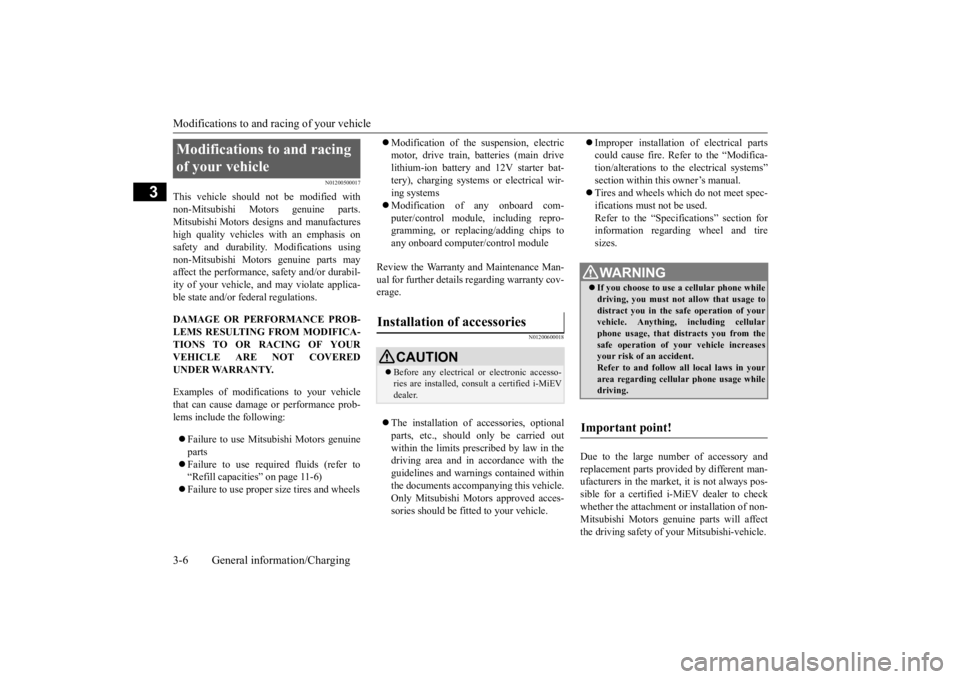
Modifications to and racing of your vehicle 3-6 General information/Charging
3
N01200500017
This vehicle should not be modified with non-Mitsubishi Motors genuine parts. Mitsubishi Motors designs and manufactureshigh quality vehicles
with an emphasis on
safety and durability.
Modifications using
non-Mitsubishi Motors genuine parts mayaffect the performance, safety and/or durabil- ity of your vehicle,
and may violate applica-
ble state and/or fe
deral regulations.
DAMAGE OR PERFORMANCE PROB- LEMS RESULTING FROM MODIFICA- TIONS TO OR RACING OF YOURVEHICLE ARE NOT COVERED UNDER WARRANTY. Examples of modifica
tions to your vehicle
that can cause damage or performance prob-lems include the following: Failure to use
Mitsubishi Motors genuine
parts Failure to use required fluids (refer to “Refill capacities” on page 11-6) Failure to use proper
size tires and wheels
Modification of the
suspension, electric
motor, drive train, batteries (main drivelithium-ion battery a
nd 12V starter bat-
tery), charging systems or electrical wir- ing systems Modification of any onboard com- puter/control module, including repro- gramming, or replac
ing/adding chips to
any onboard computer/control module
Review the Warranty and Maintenance Man- ual for further details
regarding warranty cov-
erage.
N01200600018
The installation of ac
cessories, optional
parts, etc.,
should only be carried out
within the limits prescribed by law in the driving area and in accordance with theguidelines and warnings contained within the documents accompanying this vehicle. Only Mitsubishi Motors approved acces-sories should be fitted to your vehicle.
Improper installation of
electrical parts
could cause fire. Refer to the “Modifica-tion/alterations to the electrical systems” section within this owner’s manual. Tires and wheels which do not meet spec- ifications must not be used. Refer to the “Specifi
cations” section for
information regarding wheel and tiresizes.
Due to the large number of accessory and replacement parts provided by different man-ufacturers in the market, it is not always pos- sible for a certified i-
MiEV dealer to check
whether the attachment or installation of non-Mitsubishi Motors genui
ne parts will affect
the driving safety of your Mitsubishi-vehicle.
Modifications to and racing of your vehicle
Installation of accessories
CAUTION Before any electrical or electronic accesso- ries are installed, consult a certified i-MiEV dealer.
WA R N I N G If you choose to use
a cellular phone while
driving, you must not allow that usage todistract you in the sa
fe operation of your
vehicle. Anything, including cellular phone usage, that distracts you from thesafe operation of your vehicle increases your risk of an accident. Refer to and follow all local laws in yourarea regarding cellula
r phone usage while
driving.
Important point!
BK0209800US.book 6 ページ 2014年1月14日 火曜日 午前9時26分
Page 45 of 262

High-Voltage components 3-30 General information/Charging
3
N01205700027
High voltage components and wiring cables are located as shown in the figure below.
N01205800031
A crash or impact significant enough to require an emergency response for conven- tional vehicles would
also require the same
response for electric vehicles. Also follow the instruct
ions described below
to avoid severe burns a
nd electrical shock that
may result in serious injury or death.
High-Voltage components
WA R N I N G The EV (Electric Vehicle) system uses high voltage up to DC 330 volt. The system canbe hot during and after starting and when the vehicle is shut off. Be careful of both the high voltage and
the high temperature.
Follow the warning labels that are attached to the vehicle. Never touch, disassemble, remove or replace high-voltage parts, exposed elec- trical components, cables or connectors.Failure to follow this instruction can result in severe burns
or electric shock
causing serious injury
or death. High-volt-
age cables are colore
d orange. Th
e vehicle
high voltage system has no user service- able parts. Take your
vehicle to a Certified
i-MiEV dealer for an
y necessary mainte-
nance. Always assume the hi
gh voltage battery
and associated compon
ents are energized
and fully charged.
1- Regular charge port 2- MCU 3- Main drive lithium-ion battery 4- Heater5- Air conditioner compressor 6- High voltage connector 7- Service plug8- Electric motor (Electric motor unit) 9- On board charger/DC-DC converter 10- Quick charge portIn case of a collision
WA R N I N G If your vehicle is dr
ivable, pull your vehi-
cle off the road to a safe, nearby locationand remain on the scene.Also, if possible, do
the follow
ing opera-
tions and stay out of the way of any oncoming traffic while awaiting thearrival of emergency responders.• Apply chocks to the wheels.• Move the selector
lever to the “P”
(PARK) position.• Apply the parking brake.• Open the windows,
doors and liftgate.
• Turn the electric motor switch to the “LOCK” position.• Turn on the hazard warning flashers.• Move the key away fr
om the vehicle to
prevent unintended start-up of the sys-tem by inadvertent contact with a switch or impact from the crash.
Never touch high-vol
tage wiring, connec-
tors, and other high-vol
tage parts, such as
the inverter unit and main drive lithium-ion battery. An electric shock may occur if exposed electric wires are visible when viewed from inside
or outside of your
vehicle. For their locations, see “High- voltage components” on page 3-30. If the vehicle receives a strong impact to the floor while driving, stop the vehicle in a safe place and check the floor.
BK0209800US.book 30 ページ 2014年1月14日 火曜日 午前9時26分
Page 46 of 262

High-Voltage components
General information/Charging 3-31
3
Leaks or damage to the main drive lith- ium-ion battery may result in a fire. If youdiscover them, contact emergency servicesimmediately. Since the fluid leak may be lithium manganite from the Lithium-ion battery, never touch any fluid leakingfrom the inside or outs
ide of the vehicle. If
the fluid contacts you
r skin or eyes, wash
it off immediately with a large amount ofwater and receive immediate medical attention to help
avoid serious injury.
If you are unable to sa
fely assess the vehi-
cle due to vehicle damage, do not touch the vehicle. Leave the vehicle and contactemergency services. Advise emergency responders that this is
an electric vehicle.
If a fire occurs in th
is vehicle,
leave the
vehicle as soon as possible and contact emergency services. Do not attempt toextinguish a fire by yourself. If the fire involves a lithium-ion battery, it will require large, sustained volumes of waterfor extinguishment. Using a small amount of water or the incorrect fire extinguisher can result in serious injury or death fromelectrical shock. When you leave the ve
hicle, if possible,
open the windows,
doors and liftgate to
prevent accumulation of poisonous/com- bustible gasses. This will also assist in therescue and fire fighting process.WA R N I N G
As with any vehicle fi
re, the byproducts of
combustion can be toxic. Do not inhalesmoke, vapors, or gas
from the vehicle.
Move to a safe distance upwind and uphill from the vehicle fire
and out of the way of
any oncoming traffic
while awaiting the
arrival of emergency responders. If you detect leaking
fluids, sparks, smoke,
flames, gurgling, popping or hissing noises originating from the
high voltage battery
compartment, contact emergency servicesimmediately. This may result in a fire. Physical damage to
the vehicle or high
voltage battery may re
sult in immediate or
delayed release of t
oxic and/or flammable
gases and fire. If your vehicle needs
to be towed, trans-
port the vehicle on a flatbed truck or towthe vehicle either with all wheels or the rear wheels (drive
wheels) off the ground.
If the rear wheels ar
e on the ground when
towing, this may cause damage to the elec- tric motors. This may also cause a fire, if wiring in the electric motor unit roombecomes damaged. Refer to “Towing” on page 8-12. Do not attempt to repair a damaged elec- tric vehicle yourself. Please contact a cer- tified i-MiEV dealer for service.WA R N I N G
In the event of an ac
cident that requires
body repair and painting, the vehicleshould be delivered to a Certified i-MiEVdealer to have the main drive lithium-ion battery and high voltage parts such as the inverter, including the attached wiringharness, removed prior to painting. If exposed to heat in the paint booth, the main drive lithium-ion battery will experi-ence battery capacity loss. A damaged main drive lithium-ion battery can also pose safety risks to untrainedmechanics and repair personnel.NOTE
The emergency shut-off
system will be acti-
vated and the high-voltage
system will auto-
matically turn off under the following conditions: • Certain front, side or rear collisions. • Certain EV (Electric Vehicle) system mal- functions.
When the emergency shut
-off system is acti-
vated, the ready indicato
r is turned off. Refer
to “Indicator and warning light package” onpage 5-41. If the emergency shut-off system activates, contact a Certifie
d i-MiEV dealer.
WA R N I N G
BK0209800US.book 31 ページ 2014年1月14日 火曜日 午前9時26分
Page 72 of 262
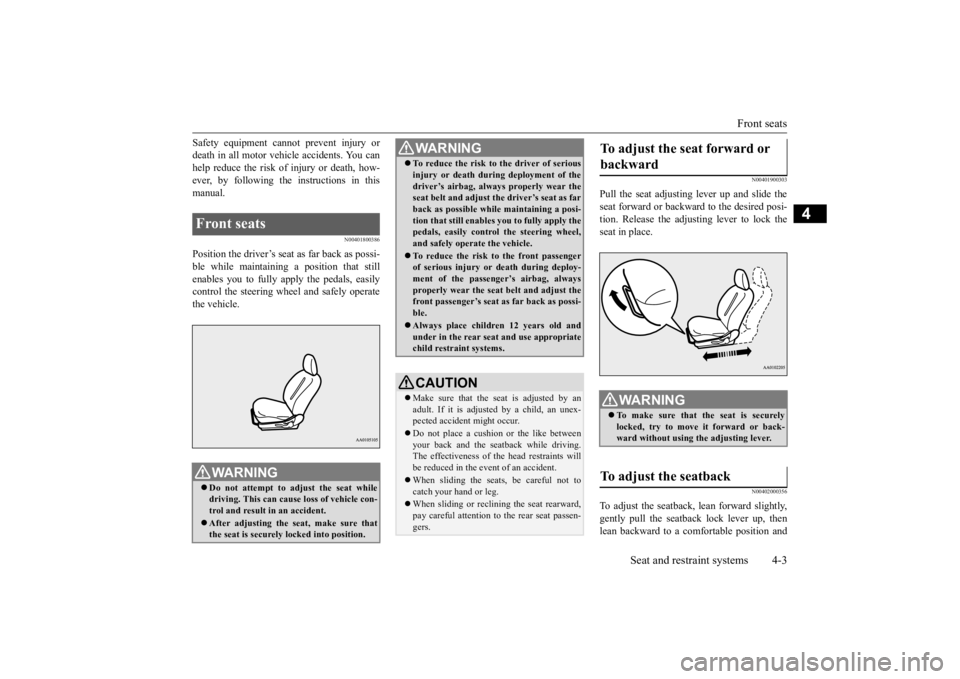
Front seats
Seat and restraint systems 4-3
4
Safety equipment cannot prevent injury or death in all motor vehi
cle accidents. You can
help reduce the risk of injury or death, how- ever, by following the instructions in this manual.
N00401800386
Position the driver’s seat
as far back as possi-
ble while maintaining a position that still enables you to fully apply the pedals, easily control the steering wh
eel and safely operate
the vehicle.
N00401900303
Pull the seat adjusting lever up and slide theseat forward or backwa
rd to the desired posi-
tion. Release the adjusting lever to lock the seat in place.
N00402000356
To adjust the seatback,
lean forward slightly,
gently pull the seatback lock lever up, then lean backward to a comfortable position and
Front seats
WA R N I N G Do not attempt to adjust the seat while driving. This can cause loss of vehicle con- trol and result
in an accident.
After adjusting the se
at, make sure that
the seat is securely locked into position.
To reduce the risk to the driver of serious injury or death during deployment of thedriver’s airbag, always
properly wear the
seat belt and adjust th
e driver’s seat as far
back as possible while maintaining a posi- tion that still enables
you to fully apply the
pedals, easily control the steering wheel, and safely operate the vehicle. To reduce the risk to the front passenger of serious injury or
death during deploy-
ment of the passeng
er’s airbag, always
properly wear the seat
belt and adjust the
front passenger’s seat as far back as possi- ble. Always place childr
en 12 years old and
under in the rear seat
and use appropriate
child restraint systems.CAUTION Make sure that the seat is adjusted by an adult. If it is adjusted by a child, an unex- pected accident might occur. Do not place a cushion
or the like between
your back and the seatback while driving. The effectiveness of the head restraints willbe reduced in the event of an accident. When sliding the seats, be careful not to catch your hand or leg. When sliding or reclining the seat rearward, pay careful attention to
the rear seat passen-
gers.WA R N I N G
To adjust the seat forward or backward
WA R N I N G To make sure that the seat is securely locked, try to move
it forward or back-
ward without using th
e adjusting lever.
To adjust the seatback
BK0209800US.book 3 ページ 2014年1月14日 火曜日 午前9時26分
Page 77 of 262
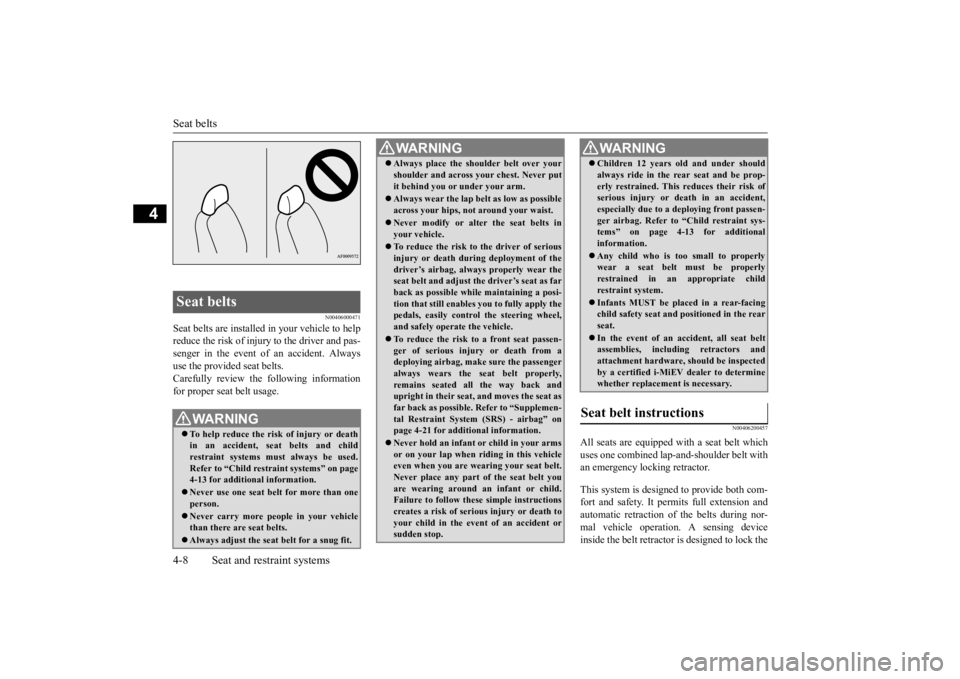
Seat belts 4-8 Seat and restraint systems
4
N00406000471
Seat belts are in
stalled in your vehicle to help
reduce the risk of injury to the driver and pas-senger in the event of an accident. Always use the provided seat belts. Carefully review the
following information
for proper seat belt usage.
N00406200457
All seats are equipped with a seat belt whichuses one combined lap-
and-shoulder belt with
an emergency locking retractor. This system is designed to provide both com- fort and safety. It permits full extension and automatic retraction of the belts during nor- mal vehicle operation.
A sensing device
inside the belt retractor is designed to lock the
Seat belts
WA R N I N G To help reduce the risk of injury or death in an accident, se
at belts and child
restraint systems must always be used. Refer to “Child restraint systems” on page 4-13 for additional information. Never use one seat belt
for more than one
person. Never carry more peop
le in you
r vehicle
than there are seat belts. Always adjust the seat
belt for a snug fit.
Always place the shou
lder belt over your
shoulder and across
your chest. Never put
it behind you or
under your arm.
Always wear the lap belt as low as possible across your hips, not around your waist. Never modify or alter the seat belts in your vehicle. To reduce the risk to the driver of serious injury or death durin
g deployment of the
driver’s airbag, always
properly wear the
seat belt and adjust th
e driver’s seat as far
back as possible while maintaining a posi-tion that still enables
you to fully apply the
pedals, easily control the steering wheel, and safely operate the vehicle. To reduce the risk to a front seat passen- ger of serious injury or death from adeploying airbag, make sure the passenger always wears the seat belt properly, remains seated all the way back andupright in their seat,
and moves the seat as
far back as possible. Refer to “Supplemen- tal Restraint System (SRS) - airbag” onpage 4-21 for additional information. Never hold an infant
or child in your arms
or on your lap
when riding in this vehicle
even when you are wearing your seat belt. Never place any part of the seat belt youare wearing around an
infant or child.
Failure to follow these simple instructions creates a risk of serious injury or death toyour child in the even
t of an accident or
sudden stop.WA R N I N G
Children 12 years ol
d and under should
always ride in the re
ar seat and be prop-
erly restrained. This reduces their risk ofserious injury or de
ath in an accident,
especially due to a deploying front passen- ger airbag. Refer to
“Child restraint sys-
tems” on page 4-
13 for additional
information. Any child who is too small to properly wear a seat belt
must be properly
restrained in an appropriate childrestraint system. Infants MUST be plac
ed in a rear-facing
child safety seat and
positioned in the rear
seat. In the event of an ac
cident, all seat belt
assemblies, including retractors and attachment hardware, should be inspectedby a certified i-MiEV dealer to determine whether replacement is necessary.
Seat belt instructions
WA R N I N G
BK0209800US.book 8 ページ 2014年1月14日 火曜日 午前9時26分
Page 78 of 262
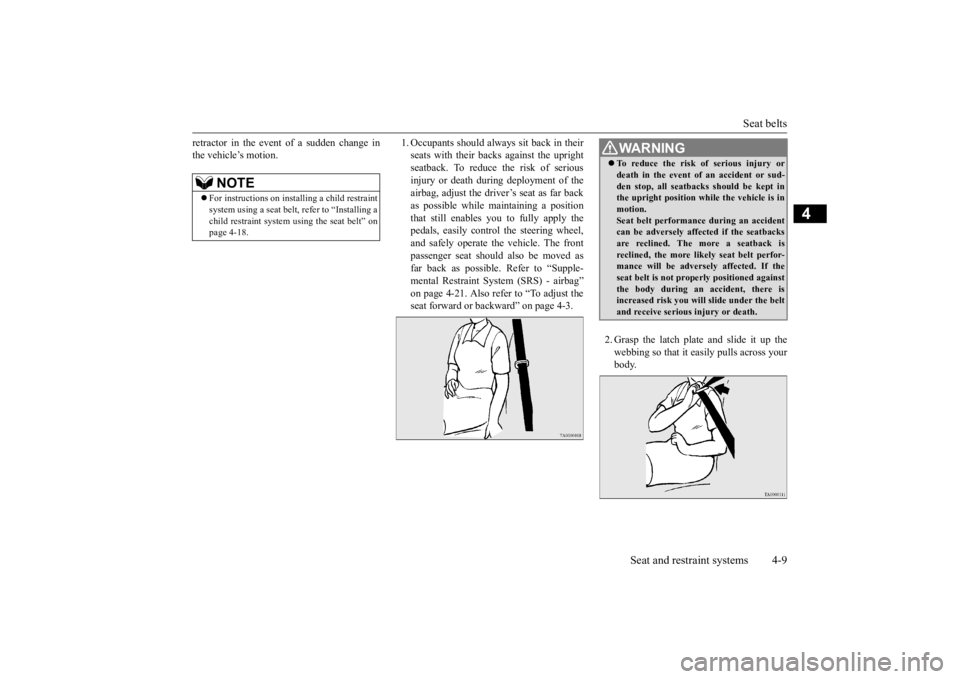
Seat belts
Seat and restraint systems 4-9
4
retractor in the event of a sudden change in the vehicle’s motion.
1. Occupants should always
sit back in their
seats with their backs against the uprightseatback. To reduce
the risk of serious
injury or death during deployment of the airbag, adjust the driver’s seat as far backas possible while maintaining a position that still enables you to fully apply the pedals, easily control the steering wheel,and safely operate the vehicle. The front passenger seat should also be moved as far back as possible. Refer to “Supple- mental Restraint System (SRS) - airbag” on page 4-21. Also refer to “To adjust theseat forward or backward” on page 4-3.
2. Grasp the latch plat
e and slide it up the
webbing so that it easily pulls across your body.
NOTE
For instructions on installing a child restraint system using a seat belt
, refer to “Installing a
child restraint system
using the seat belt” on
page 4-18.
WA R N I N G To reduce the risk of serious injury or death in the event of
an accident or sud-
den stop, all seatbacks should be kept inthe upright position while the vehicle is in motion. Seat belt performance during an accidentcan be adversely affect
ed if the seatbacks
are reclined. The more a seatback is reclined, the more likely seat belt perfor-mance will be advers
ely affected. If the
seat belt is not prop
erly positioned against
the body during an accident, there isincreased risk you will slide under the belt and receive serious
injury or death.
BK0209800US.book 9 ページ 2014年1月14日 火曜日 午前9時26分
Page 90 of 262
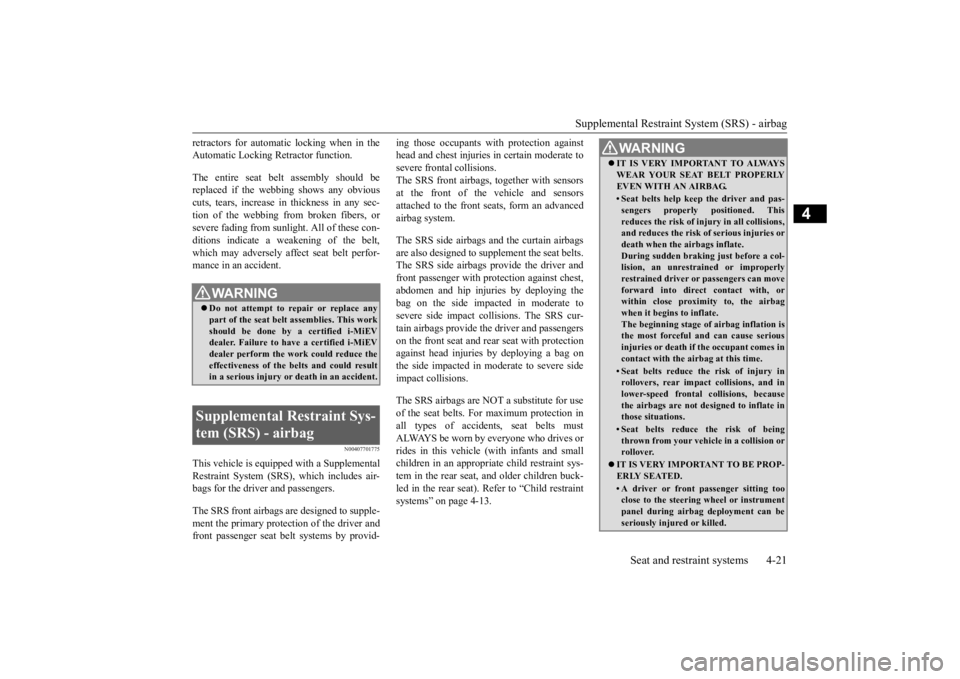
Supplemental Restraint System (SRS) - airbag
Seat and restraint systems 4-21
4
retractors for automatic locking when in the Automatic Locking Retractor function. The entire seat belt assembly should be replaced if the webbing shows any obvious cuts, tears, increase in thickness in any sec- tion of the webbing from broken fibers, orsevere fading from sunlig
ht. All of these con-
ditions indicate a weakening of the belt, which may adversely affe
ct seat belt perfor-
mance in an accident.
N00407701775
This vehicle is equippe
d with a Supplemental
Restraint System (SRS), which includes air-bags for the driver and passengers. The SRS front airbags are designed to supple- ment the primary protection of the driver and front passenger seat
belt systems by provid-
ing those occupants w
ith protection against
head and chest injuries
in certain moderate to
severe frontal
collisions.
The SRS front airbags, together with sensors at the front of the
vehicle and sensors
attached to the front seats, form an advanced airbag system. The SRS side airbags and the curtain airbags are also designed to supp
lement the seat belts.
The SRS side airbags provide the driver and front passenger with pr
otection against chest,
abdomen and hip injuries by deploying the bag on the side impacted in moderate to severe side impact collisions. The SRS cur-tain airbags provide the driver and passengers on the front seat and rear seat with protection against head injuries by deploying a bag onthe side impacted in m
oderate to severe side
impact collisions. The SRS airbags are NOT a substitute for use of the seat belts. For maximum protection inall types of accident
s, seat belts must
ALWAYS be worn by everyone who drives or rides in this vehicle
(with infants and small
children in an appropriate child restraint sys- tem in the rear seat, and older children buck- led in the rear seat). Re
fer to “Child restraint
systems” on page 4-13.
WA R N I N G Do not attempt to repair or replace any part of the seat belt assemblies. This workshould be done by a certified i-MiEV dealer. Failure to have a certified i-MiEV dealer perform the work could reduce theeffectiveness of the belts and could result in a serious injury or
death in an accident.
Supplemental Restraint Sys- tem (SRS) - airbag
WA R N I N G IT IS VERY IMPORTANT TO ALWAYS WEAR YOUR SEAT BELT PROPERLYEVEN WITH AN AIRBAG.• Seat belts help keep the driver and pas-sengers properly positioned. Thisreduces the risk of injury in all collisions, and reduces the risk of serious injuries or death when the
airbags inflate.
During sudden braking just before a col- lision, an unrestra
ined or
improperly
restrained driver or passengers can moveforward into direct contact with, or within close proximi
ty to, the airbag
when it begins to inflate.The beginning stage of
airbag inflation is
the most forceful and can cause serious injuries or death if the occupant comes incontact with the airbag at this time. • Seat belts reduce the risk of injury inrollovers, rear impact collisions, and in lower-speed frontal collisions, because the airbags are not de
signed to inflate in
those situations.• Seat belts reduce the risk of beingthrown from your vehi
cle in a collision or
rollover.
IT IS VERY IMPORTANT TO BE PROP- ERLY SEATED.• A driver or front passenger sitting tooclose to the steering wheel or instrument panel during airbag deployment can beseriously injured or killed.
BK0209800US.book 21 ページ 2014年1月14日 火曜日 午前9時26分